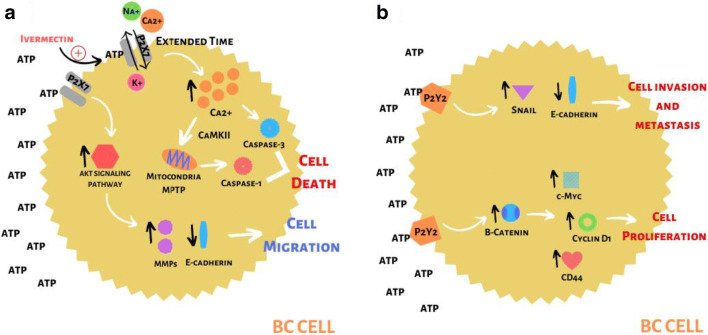Fig. 2.
a Among P2X receptors, the P2X7 is highlighted within the context of BC. This receptor has a low affinity for ATP, requiring high concentrations of this molecule (such as those found in the TME) for its activation. When the interaction between ATP and P2X7 occurs quickly, there is the formation of the macropore that allows a selective passage of ions, with an influx of Na+ and Ca2+, and an efflux of K+. This passage of ions leads to the activation of signaling pathways such as AKT, which promotes increased levels of MMPs and decreased expression of E-cadherin, both of which are related to increased migration and invasiveness of the tumor. On the other hand, when the interaction between ATP and P2X7 becomes prolonged, there is a loss of channel selectivity, leading to a significant increase in intracellular Ca2+ levels. Under these conditions, there will be the activation of apoptotic and necrotic pathways. Ca2+ will promote the activation of calmodulin-dependent protein kinase II (CaMKII), which in turn will activate the mitochondrial permeability transition pore (MPTP), leading to the release of caspase-1, which is related to the necrotic process. Also, Ca2+ will also lead to the activation of caspase-3, related to the cell’s apoptotic pathway. Both caspases will promote cell death. It should be noted that one of the activities developed by ivermectin is to increase the sensitivity of P2X7 to ATP, causing a prolonged activation of this receptor to occur, thus activating the cell death pathways, favoring the control of tumor growth. b Among the P2Y family, the receptor that has a great correlation with BC is P2Y2. This receptor is found highly expressed in the cells that make up the edges of the tumor, and when activated by ATP, it promotes an increase in the Snail molecule that controls the expression of genes related to invasion and metastasis, and a decrease in E-cadherin. Such conditions favor the invasion and metastasis of tumor cells. Furthermore, the activation of P2Y2 promotes an increase in β-catenin, which in turn leads to an increase in the levels of the molecules c-Myc, cyclin D1, and CD44, all of them related to the control and progression of the cell cycle. Thus, P2Y2, in addition to promoting invasion and metastasis, also promotes the proliferation of BC cells

